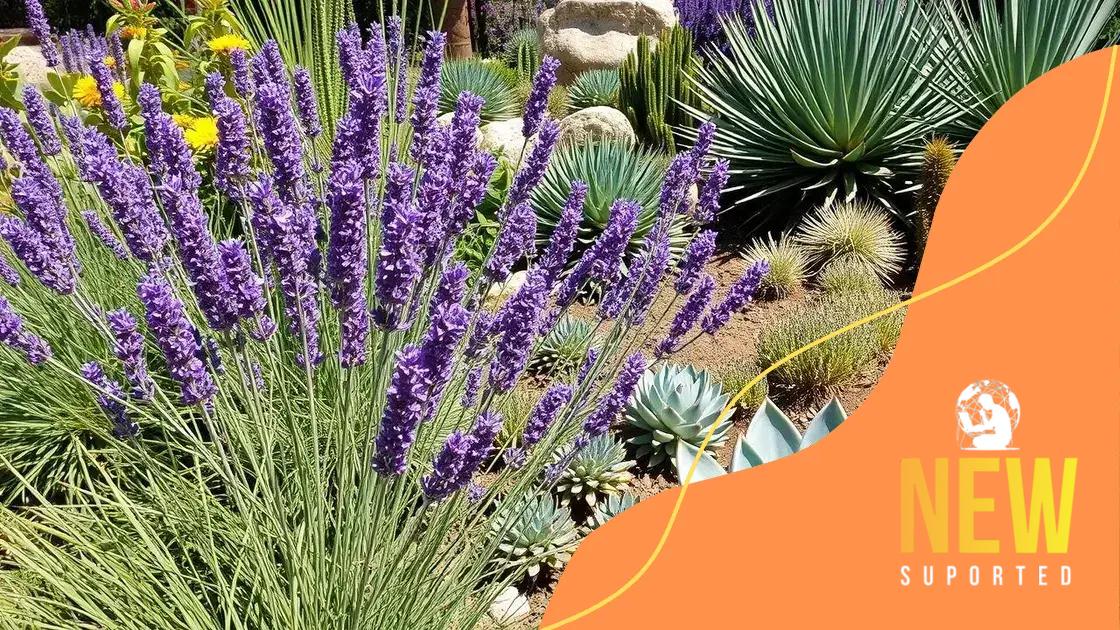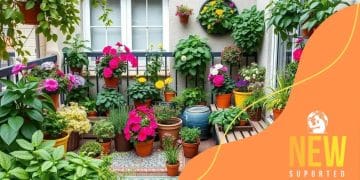The best plants for creating a low-maintenance garden

The best plants for creating a low-maintenance garden include succulents, drought-resistant varieties, and perennials like lavender and daylilies, which thrive with minimal care and watering.
The best plants for creating a low-maintenance garden can change your approach to gardening. Do you want a beautiful space without the constant upkeep? Let’s dive into plants that will thrive with minimal effort.
Choosing the right plants for low maintenance
Choosing the right plants for a low-maintenance garden is essential for anyone looking to simplify their gardening experience. By selecting the appropriate varieties, you can create a beautiful space that requires minimal upkeep.
Factors to Consider
When selecting plants, keep in mind several important factors. These will help you choose plants that not only thrive but also fit your lifestyle.
- Climate: Ensure the plants you choose are suitable for your local climate conditions.
- Soil Type: Different plants have varying soil requirements, so it’s important to consider the type of soil in your garden.
- Sunlight: Assess how much sunlight your garden receives throughout the day. Some plants require full sun, while others prefer shade.
- Water Needs: Choose plants that have similar water requirements to make watering easier.
Consider plants that naturally thrive in your area’s climate. Native plants often require less water and care because they are adapted to the local environment. For instance, lavender and sedum are excellent choices that provide beauty and require minimal fuss. They can be both decorative and functional, as they attract pollinators.
Low-Maintenance Plant Options
Some plant options are particularly favored for low-maintenance gardens.
- Succulents: These thrive in dry conditions and need little water, making them ideal for busy gardeners.
- Perennials: Once established, they come back year after year, reducing planting and care requirements.
- Drought-resistant varieties: Plants like agave and ornamental grasses can survive with less water.
Incorporating a variety of these plants will not only ease your gardening burden but also enhance the aesthetic appeal of your space. With proper planning and consideration of your garden’s unique environment, you can effortlessly enjoy a vibrant, low-maintenance garden without the stress!
Top perennials for easy care gardening
When it comes to gardening, choosing the right plants can make a significant difference in how much time and effort you spend maintaining your space. Perennials are a fantastic option for those looking for low-maintenance plants that bloom year after year.
Why Choose Perennials?
Perennials save you time and money since they return every season without needing to be replanted. This means less work for you in the long run.
- Longevity: Unlike annuals, perennials last for multiple years, enriching your garden season after season.
- Diverse Options: There are countless varieties of perennials that can fit any garden style, from wildflower meadows to formal landscapes.
- Low Maintenance: Once established, many perennials require minimal care, making them ideal for busy gardeners.
Some top choices include daylilies, which are known for their bright blooms and resilience. They thrive in different conditions, requiring minimal watering. Another great option is the hosta, offering lush foliage that adds texture to shady areas of your garden. Additionally, sedum, with its succulent leaves, is a drought-tolerant choice that requires little attention.
Caring for Perennials
Even though perennials are generally low maintenance, they still benefit from a few care tips. Start by ensuring they are planted in the right location with proper sunlight and soil conditions. Regularly removing dead flowers, known as deadheading, keeps them looking fresh and encourages further blooms. Irrigation is also essential, especially in the first season. Once established, many perennials can survive with just natural rainfall.
By selecting the right perennials, you can create a stunning garden that flourishes with little effort. Finding varieties that suit your local climate and garden style is key to establishing a lasting garden without the headache of constant upkeep.
Drought-resistant plants to consider

Choosing drought-resistant plants is essential for anyone looking to maintain a beautiful garden while conserving water. These plants are specifically adapted to survive with minimal moisture, making them ideal for low-maintenance gardening.
Benefits of Drought-Resistant Plants
Drought-resistant plants have many advantages that make them appealing to gardeners.
- Water Conservation: By choosing these plants, you significantly reduce the amount of water needed for your garden.
- Low Maintenance: Many drought-resistant varieties require less frequent watering and care.
- Environmental Impact: You contribute to water preservation, which is crucial in areas that experience dry spells.
Some popular options include lavender, which adds stunning color and fragrance while thriving in dry conditions. Another excellent choice is agave, known for its unique structure and ability to store water. Succulents, such as sedum, also come in various shapes and sizes, perfect for adding texture to your garden without requiring much care.
Planting Tips
When planting drought-resistant plants, consider grouping them together to maximize water efficiency. This technique creates microclimates that help retain moisture around the roots. Incorporating organic mulch around the plants can also help keep the soil moist and reduce evaporation.
Another essential tip is to prepare your soil well. Good drainage is vital, as these plants don’t thrive in waterlogged conditions. Adding gravel or sand can improve drainage and provide a better environment for rooting.
By selecting the right drought-resistant plants, you can enjoy a vibrant garden that is not only beautiful but also sustainable and easy to maintain.
How to design your garden layout
Designing your garden layout can greatly enhance its beauty and functionality. A well-planned garden not only looks appealing but also maximizes space and promotes healthy plant growth.
Understanding Your Space
Begin by assessing your available space. Take note of the sun and shade patterns throughout the day. Identifying areas that receive full sun, partial shade, or full shade is crucial for selecting the right plants. You also need to evaluate the size of your garden and any existing structures or features.
- Mark the Boundaries: Use stakes or string to outline the garden area clearly.
- Identify Existing Features: Consider trees, fences, and pathways that may influence your layout.
- Measure Dimensions: Taking accurate measurements helps you plan efficiently.
As you think about your layout, imagine how you want your garden to look. Do you want a formal design with structured beds, or a more natural, informal style? Incorporating various elements like paths, seating areas, and focal points can enhance the overall experience.
Creating a Functional Design
Next, consider the arrangement of plants. Grouping plants with similar water and sunlight needs will simplify care. For example, place drought-resistant plants together in a sunny spot to conserve water.
- Incorporate Layers: Use taller plants at the back and shorter ones at the front for a tiered effect.
- Add Pathways: Design paths to provide easy access to all parts of the garden.
- Include Seating Areas: Create spots to relax and enjoy your garden.
Don’t forget to factor in seasonal changes. Select a mix of plants that bloom at different times to ensure year-round interest. By planning your garden layout carefully, you’ll create a beautiful and functional space that is enjoyable for both you and your visitors.
Tips for maintaining your low-maintenance garden
Maintaining a low-maintenance garden does not have to be a demanding task. With the right strategies, you can keep your garden looking its best with minimal effort.
Watering Wisely
One of the most crucial aspects of garden care is watering. It’s essential to develop a smart watering routine to promote plant health without overdoing it.
- Use mulch: Applying a layer of organic mulch around your plants helps retain moisture and suppress weeds.
- Water early: Water your garden in the morning to reduce evaporation and ensure plants have enough moisture for the day.
- Invest in drip irrigation: This method provides water directly to the roots, saving both water and time.
When planting, consider using drought-resistant plants, as they require less frequent watering. Native plants often thrive better in local conditions and need less care overall.
Weed Control
Weeds can compete with your cherished plants for nutrients and water. Managing them effectively can simplify your garden care routine.
- Regularly check for weeds: A quick weekly inspection can prevent them from taking over.
- Use landscape fabric: This barrier can help limit weed growth while allowing water and nutrients to reach your plants.
- Practice natural methods: Hand pulling or using vinegar can help eliminate weeds without chemicals.
Keep an eye on pest control as well. Once every few weeks, check for any signs of pests. Encourage beneficial insects like ladybugs, which help control harmful pests naturally.
Fertilizing and Pruning
Low-maintenance doesn’t mean no maintenance. Regular fertilizing and occasional pruning help keep your plants healthy.
- Choose slow-release fertilizers: These provide nutrients over time without much effort required from you.
- Pruning: Minimal pruning can encourage healthy growth and flowering. Focus on removing dead or damaged branches.
- Seasonal care: A light clean-up in spring and fall can keep your garden in top shape.
By following these simple tips, you can enjoy a low-maintenance garden that remains vibrant and healthy with very little effort.
Maintaining a low-maintenance garden is achievable and rewarding. By using the tips outlined, such as smart watering, effective weed control, and careful plant selection, you can create a beautiful outdoor space that requires minimal effort. Regular checks and seasonal care ensure your garden stays healthy and vibrant. Enjoy your gardening experience without the stress of high maintenance, and let your plants thrive effortlessly in the sunlight!
FAQ – Frequently Asked Questions about Low-Maintenance Gardening
What are the best plants for a low-maintenance garden?
Some of the best plants include succulents, lavender, daylilies, and drought-resistant varieties that thrive with minimal care.
How often should I water my low-maintenance garden?
Water your garden early in the morning and use mulch to retain moisture, reducing the need for frequent watering.
How can I control weeds in my garden easily?
Regularly check for weeds, use landscape fabric, and apply mulch to prevent their growth without much effort.
What is the benefit of using slow-release fertilizers?
Slow-release fertilizers provide nutrients over time, reducing the frequency of application and ensuring your plants receive consistent nourishment.






